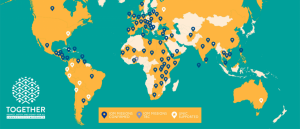Global Migration Film Festival — Critique
The International Organization for Migration (IOM) or UN Migration Agency held a Global Migration Film Festival in December 2016 and will be holding one in December 2017 as well. The slogan of the festival and its intended purpose is “promoting diversity and inclusion through film.” The 2016 festival included screenings of selected films created by various filmmakers from various places around the world. The 2016 festival took place in 89 countries and included over 220 free screenings of the film. The screenings also included debates and discussions surrounding the challenges of and related to migration. The desired effect of the festival is to foster empathy while fighting harmful narratives against migrants globally. The Global Migration Film Festival (GMFF) also partnered with the “I am a migrant” campaign as well as the “Together” campaign from the UN. The three share a similar goal of strengthening the social contract between host countries and communities, and refugees and migrants in addition to changing negative perceptions and attitudes towards migrants.



The festival aims to convey through film (in English or with English subtitles) the migrant experience, their motives, as well as the realities of migration. The IOM intends for the Global Migrant Film Festival to be just that, global. The project’s hope is to reach a widespread and international audience in order to prevent negative perceptions and instead promote positive and realistic ones. Specifically, the IOM Iraq office also participated in the festival while also conducting a massive relief effort. There, Kurdish-language films were also screened in Erbil. The head of the IOM Erbil office expressed positive sentiments towards the festival and cited it as a beacon of hope during troubling times:
“It means so much to us to be able to do this, in the midst of this emergency. It says a lot about all of our efforts to restore stability and a positive outlook for people here as they look to the future.”
Various IOM offices also conducted screenings, reaching a global audience and resulting in global responses to it. Obviously, the festival’s recurrence this year suggests a level of success and popularity. The IOM office in Portugal noted that “After the film screening we received a lot of positive feedback on our organization, as well as requests to organize more similar events that raise awareness. The strength of our event was due to the diversity of the attendees which allowed all to discuss and exchange ideas with other people with different mindsets.” However, there does not seem to be great knowledge about the festival outside of related organizations or participants of it. Perhaps the films screened were more well-known but as a whole, the festival seems to be under the radar. “Screen Africa” a South African a media news source cited the festival as “unique” and painted the festival positively and promoting attendance to the South African screenings.
The festival and its goals seem admirable and well executed in certain respects. However, the targeted global audience does not seem to be well informed on the festival or the selected films. While the international offices and the local organizations that work with IOM to promote and organize the festival share positive responses to the festival and the films. Many of those who attended were as the GMFF’s website states migrants, government officials, students, local community representatives, and donor representatives. This audience, though important, are already sympathetic to the migrant cause. Rather than make aware an uninformed individual or convert a negative perception, the festival seemed to share stories to a possibly informed and supportive audience. The festival also seems to have been a celebration of migrants, their stories, their struggles, and their fight, and to express solidarity and spread a message of hope during a time of “crisis” rather than one that changed the minds of those aggravating the struggles of migrants. While still a noble achievement, I think the 2017 festival can be even more successful and impactful if advertised to a larger, less specific and more public audience. As a more universal language of images and emotions is displayed through film, the festival has the possibility of changing many minds and informing many as well. As a UN-led or partnered campaign and project, the possibilities for widespread knowledge and impact of the festival are huge with the right approach.
Recent Comments